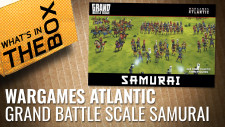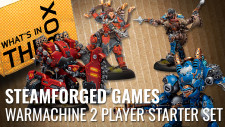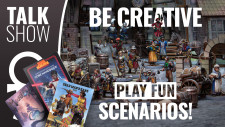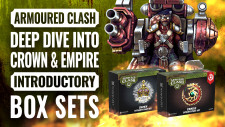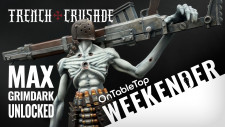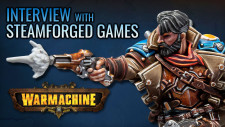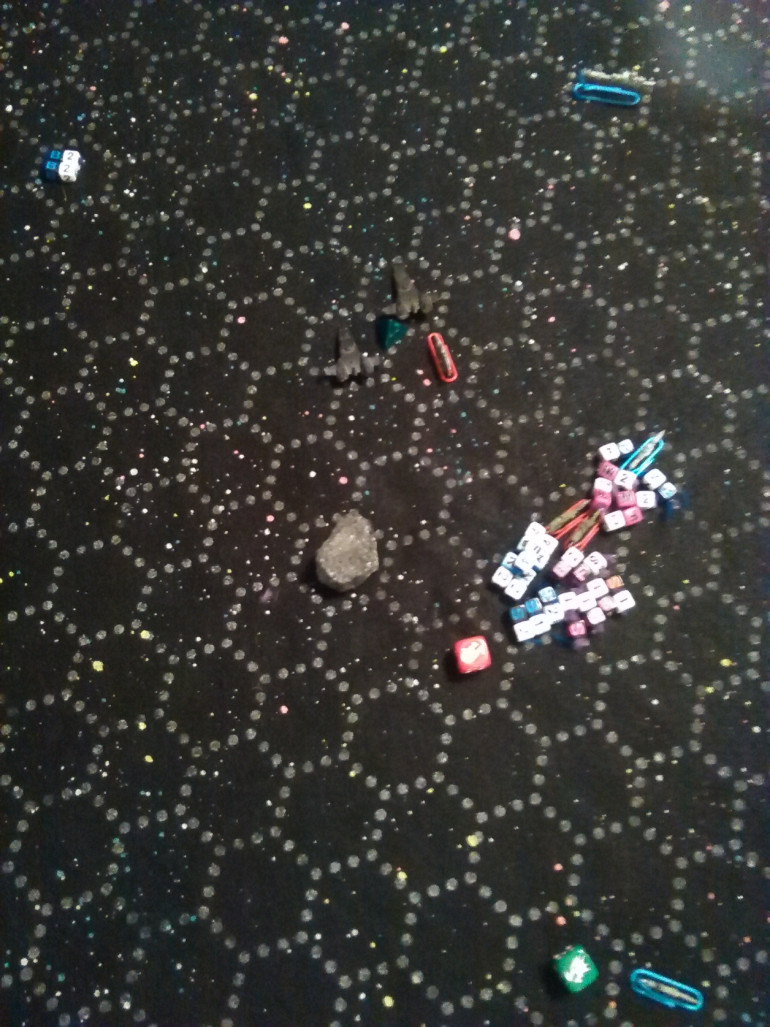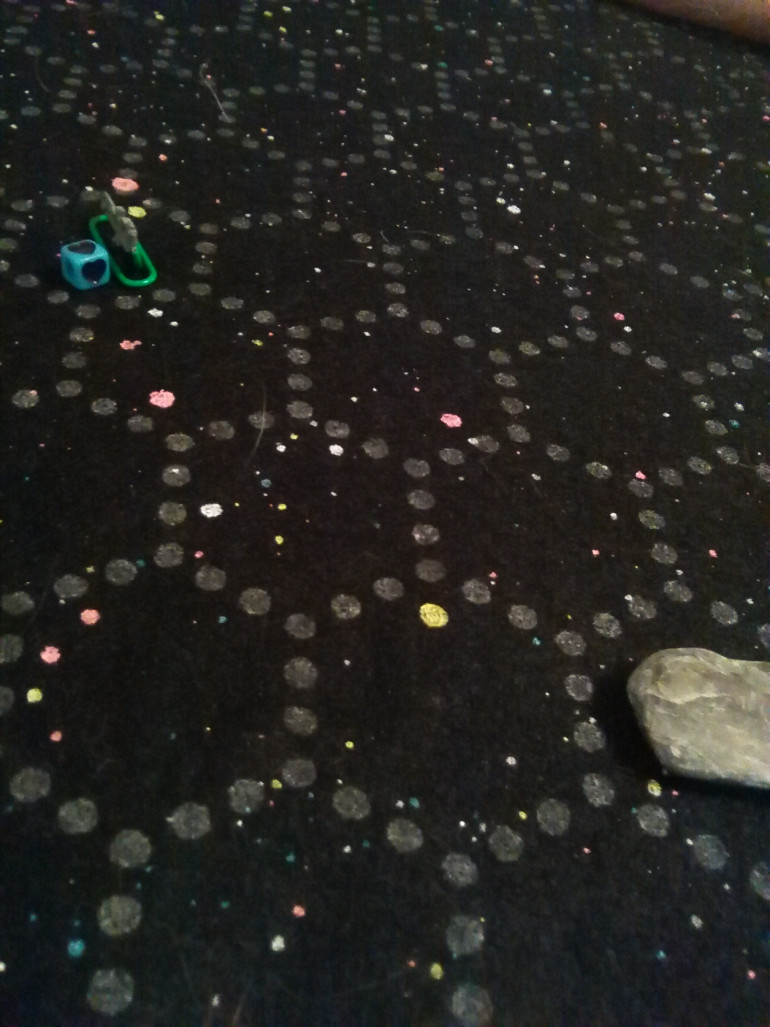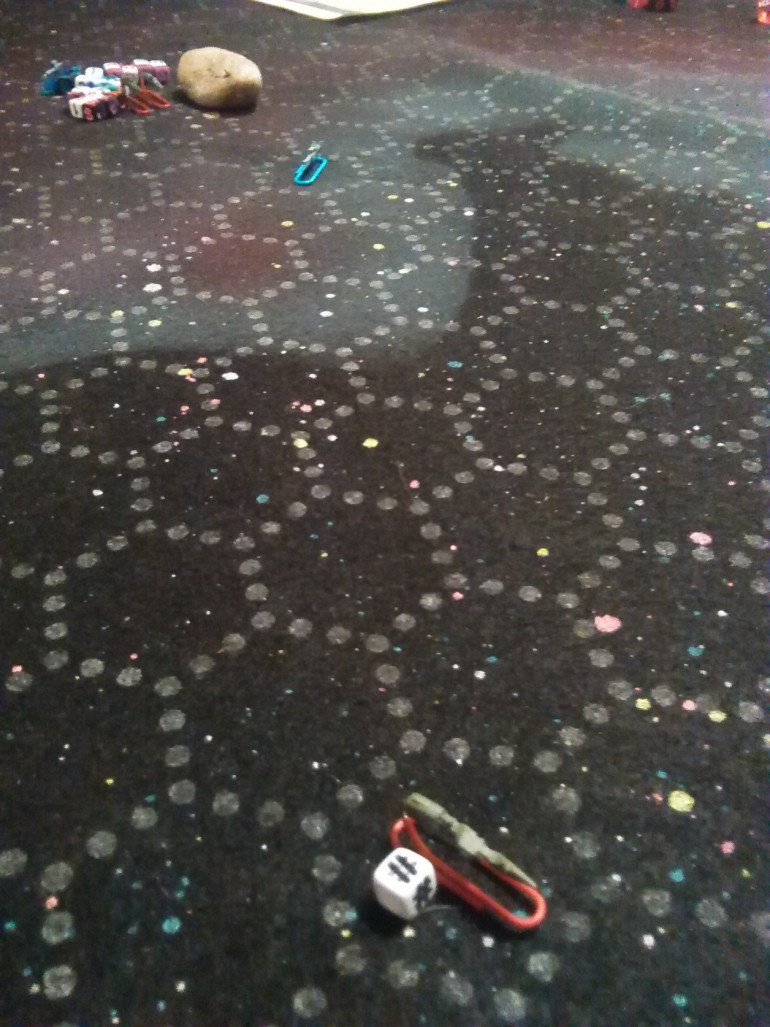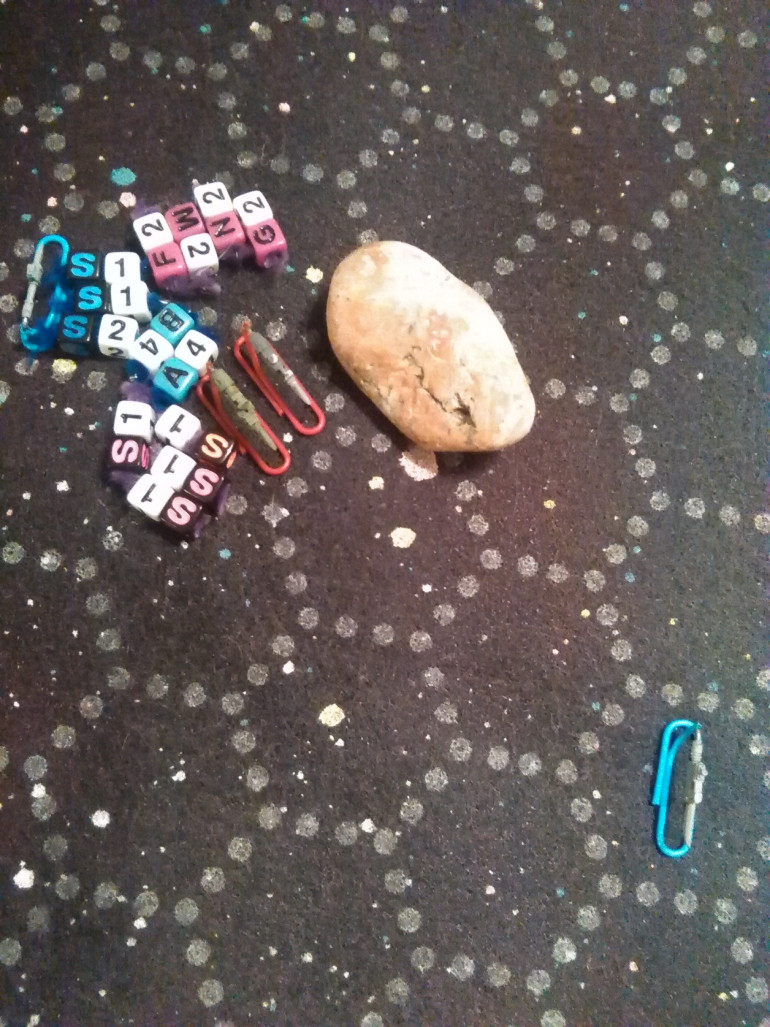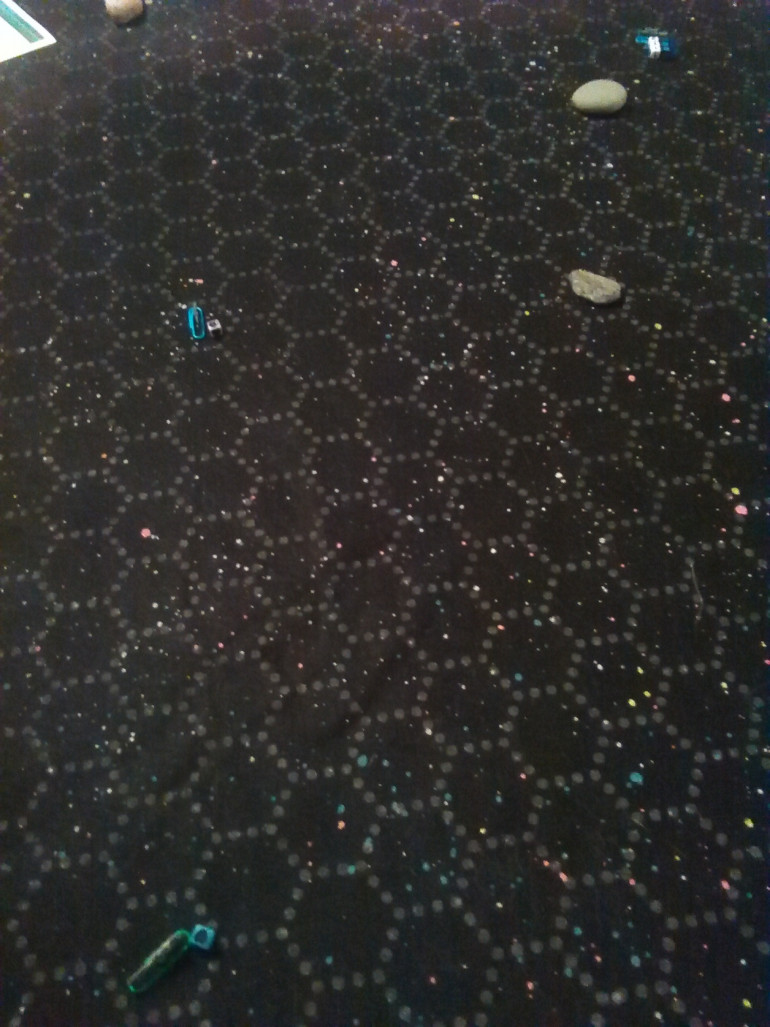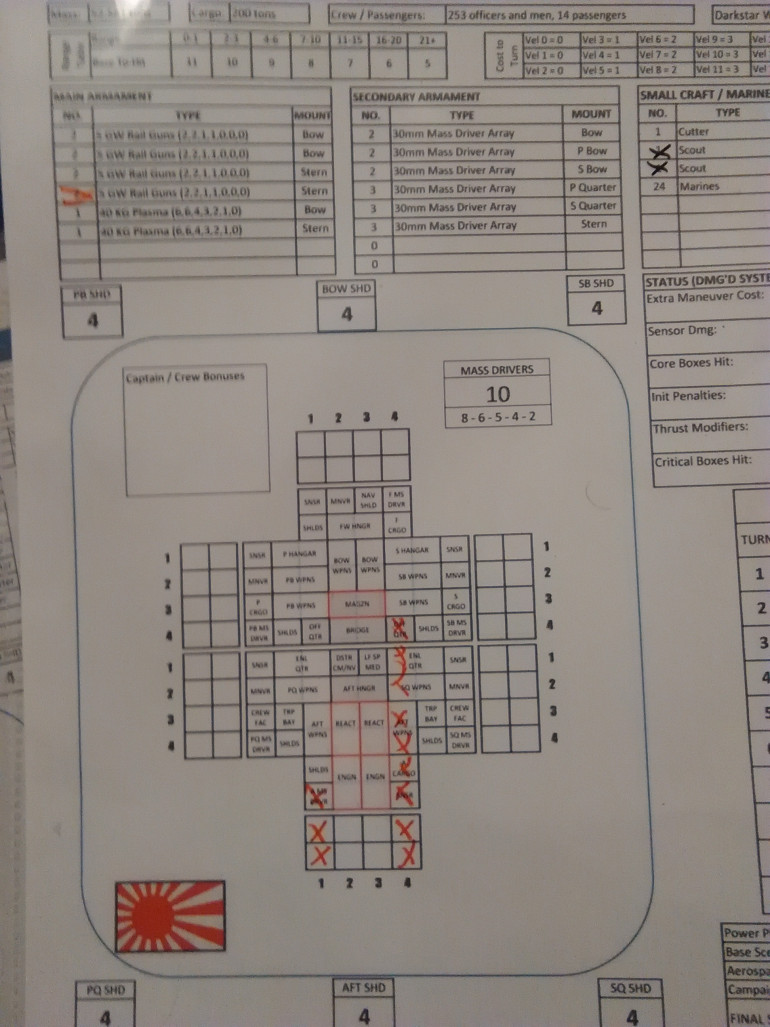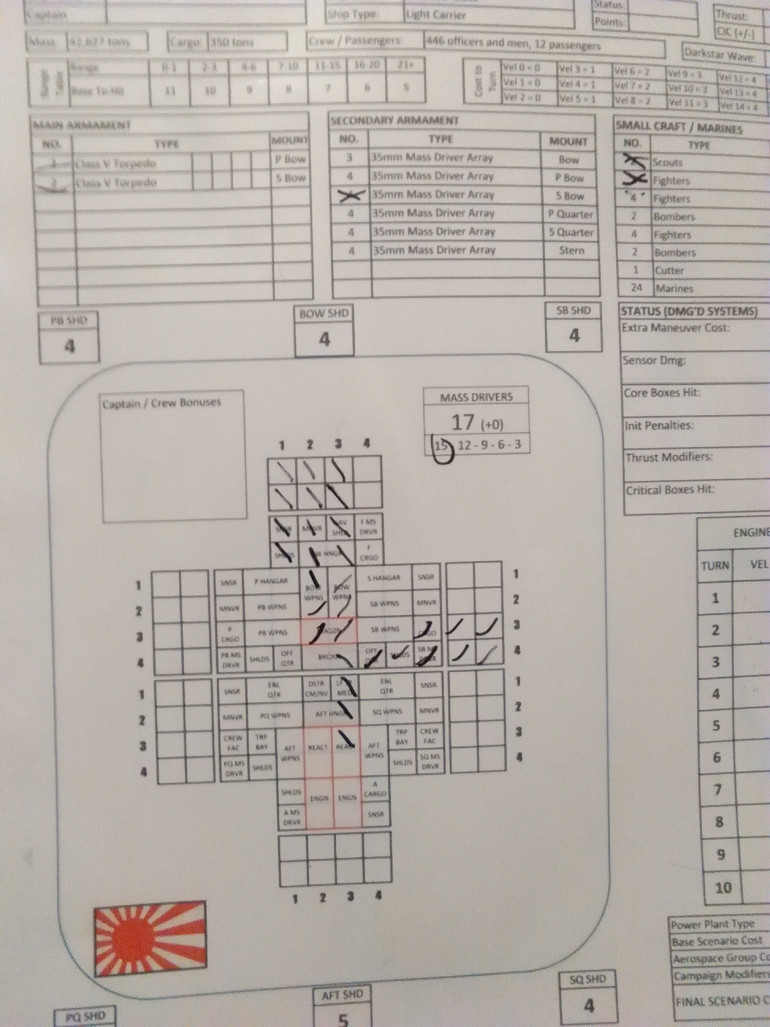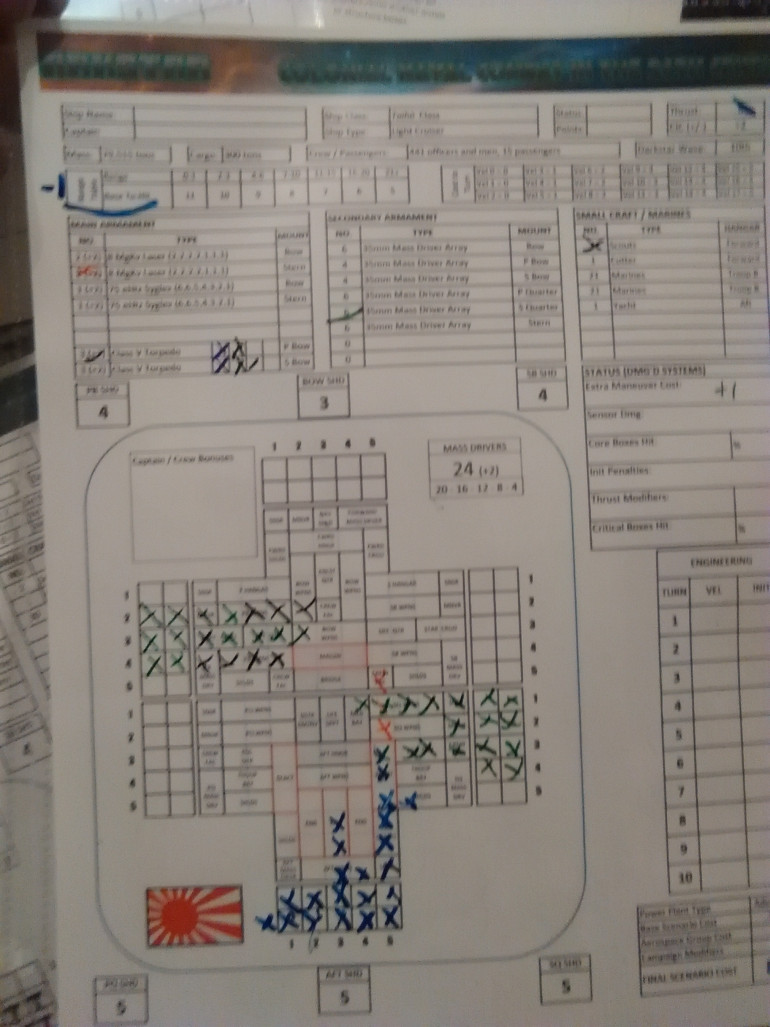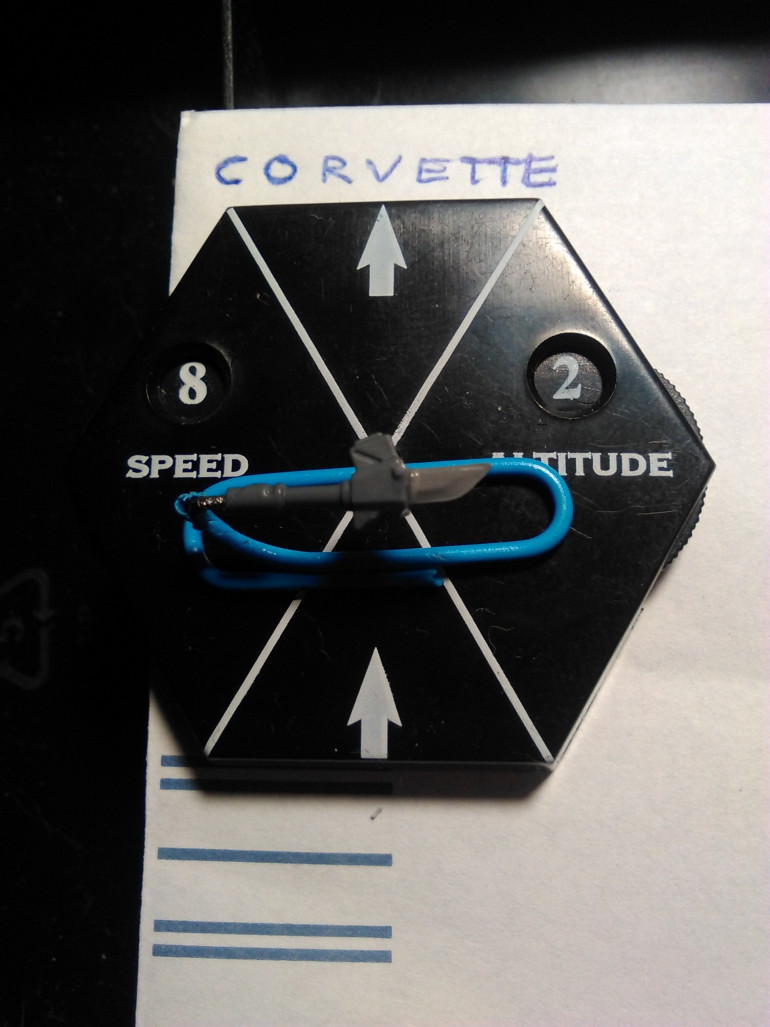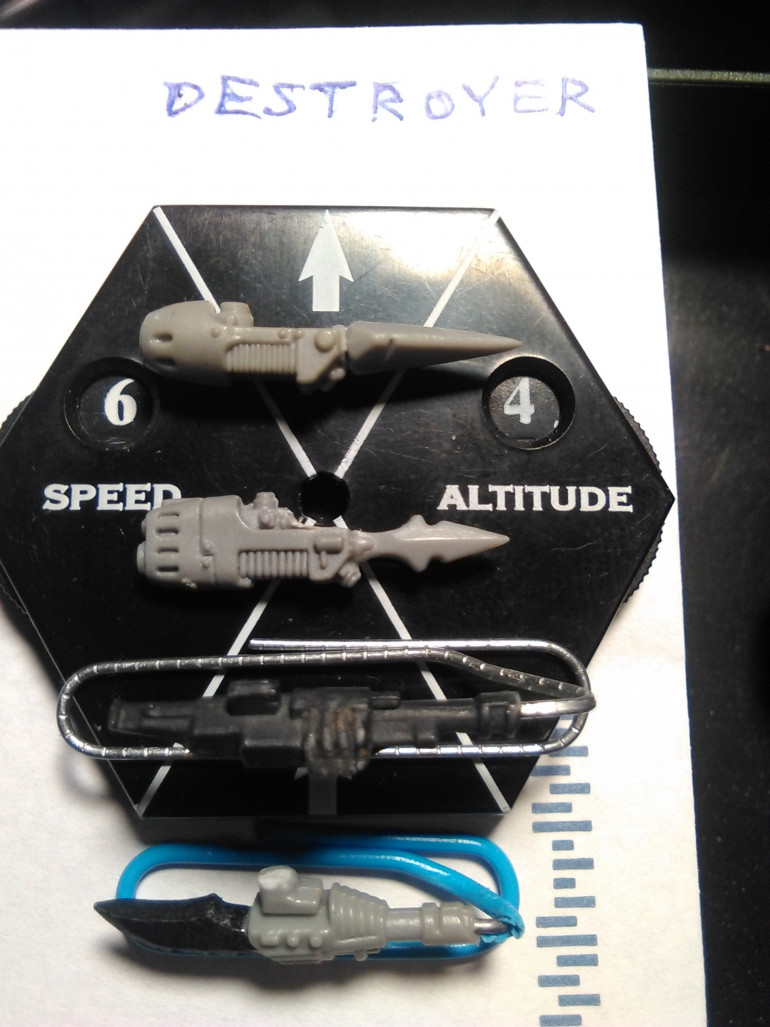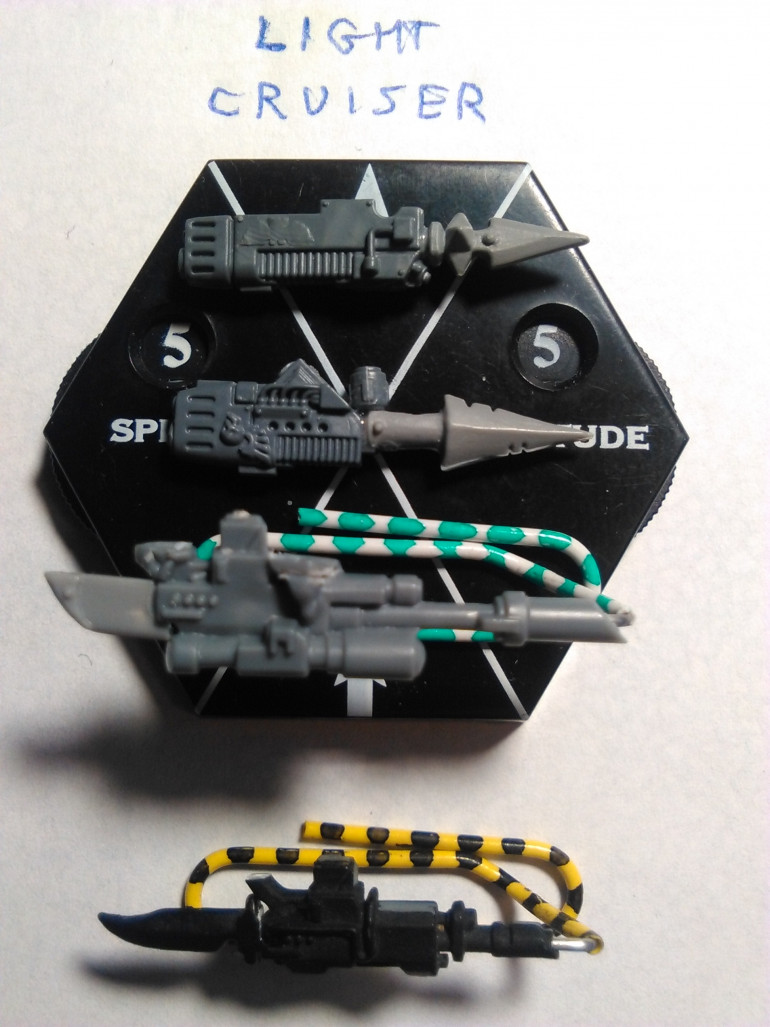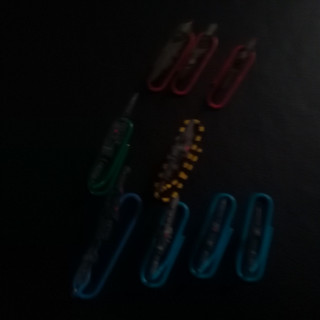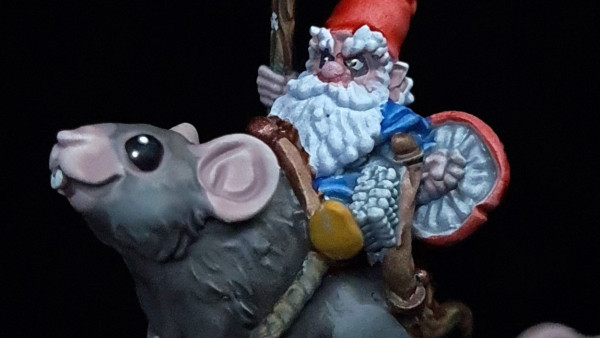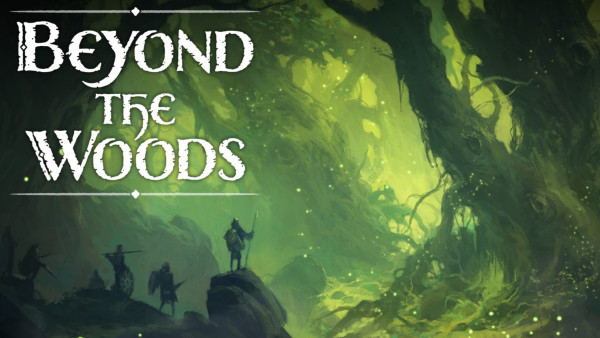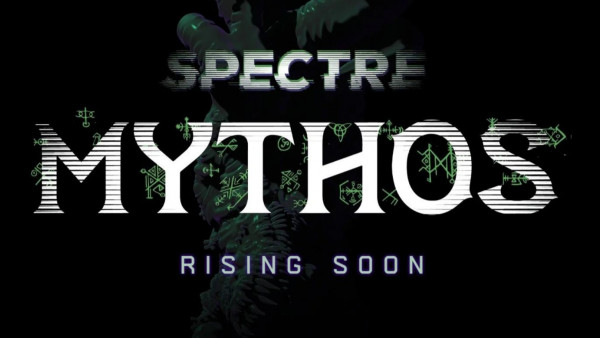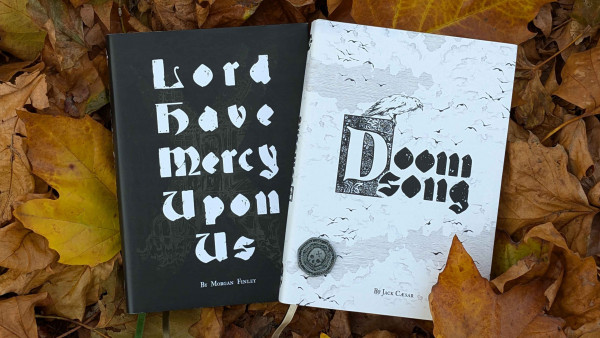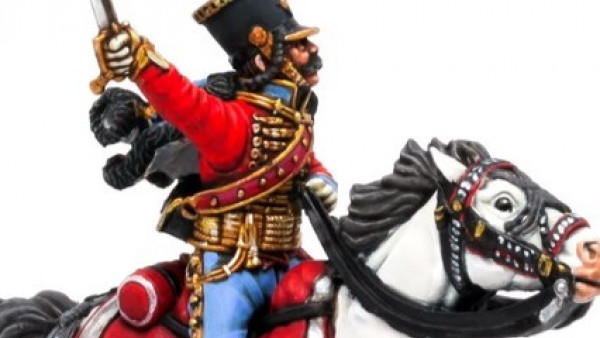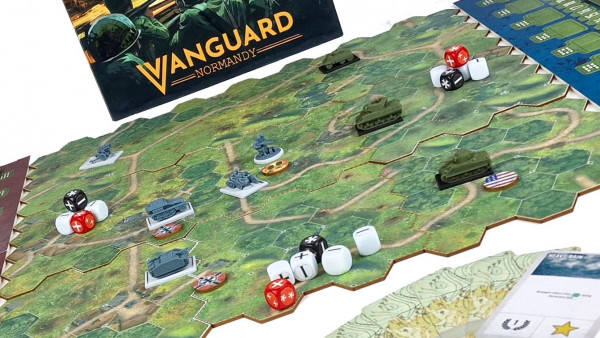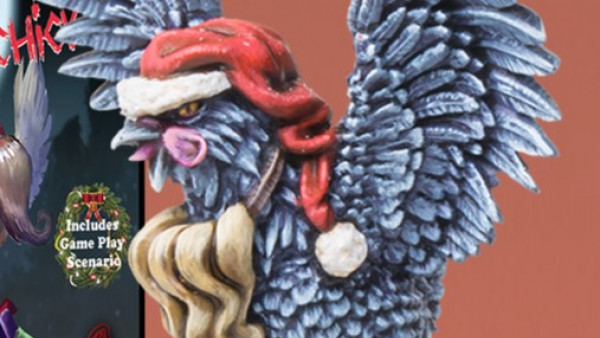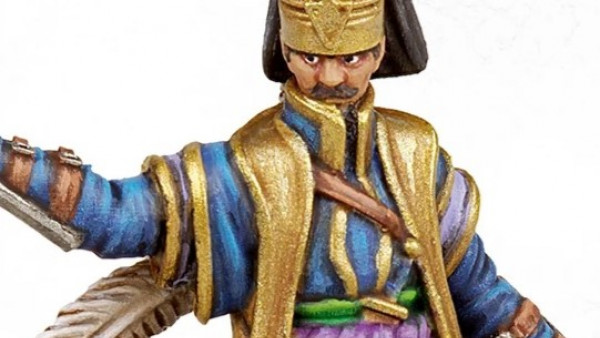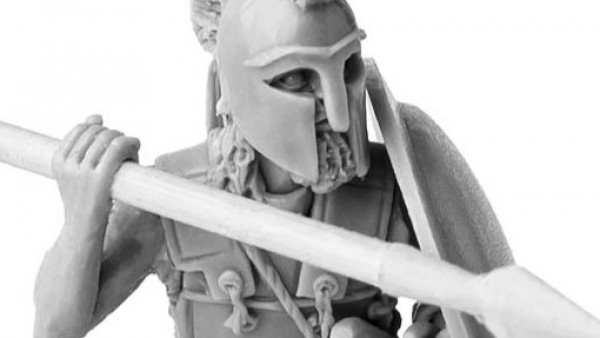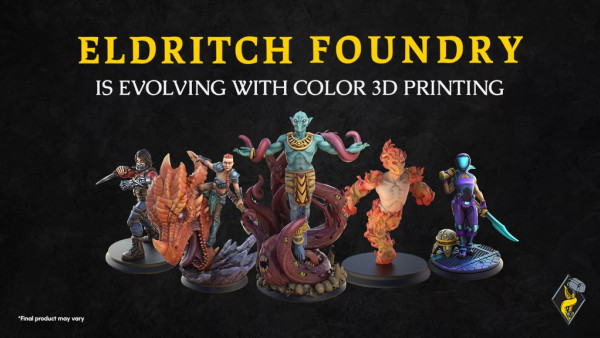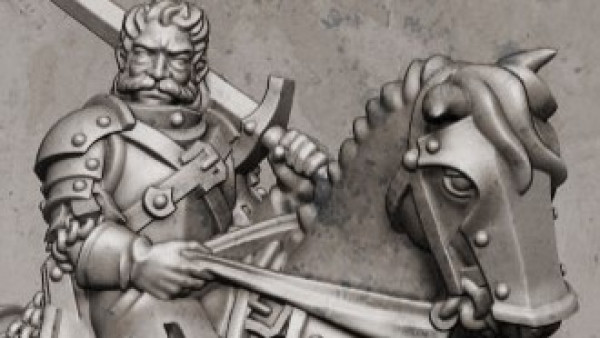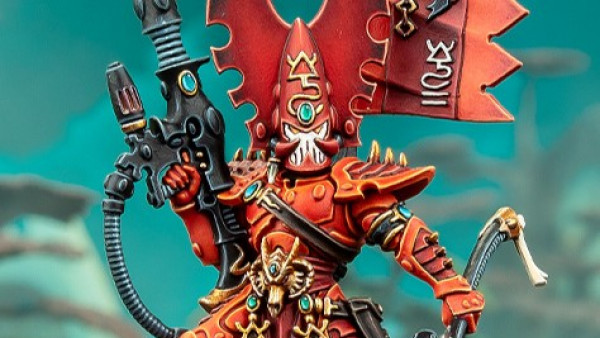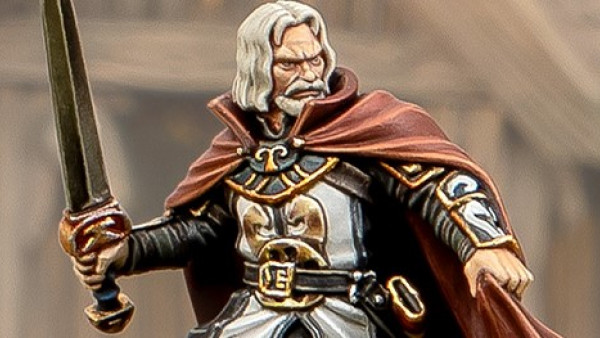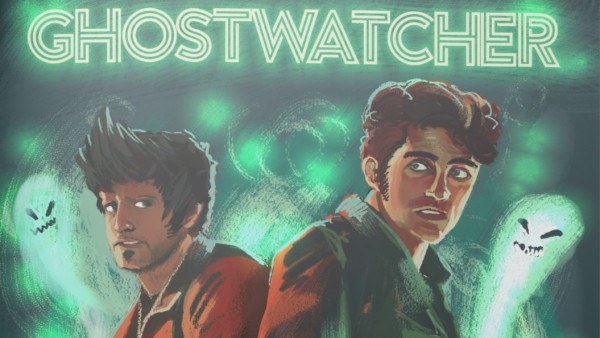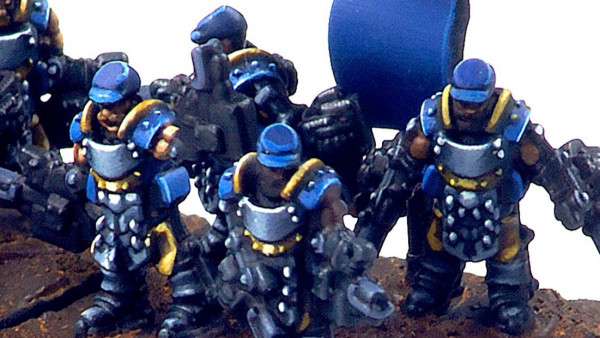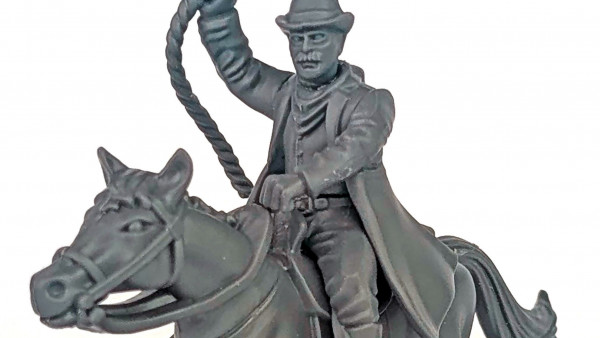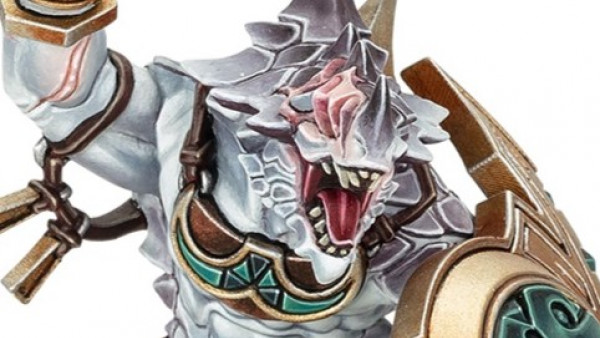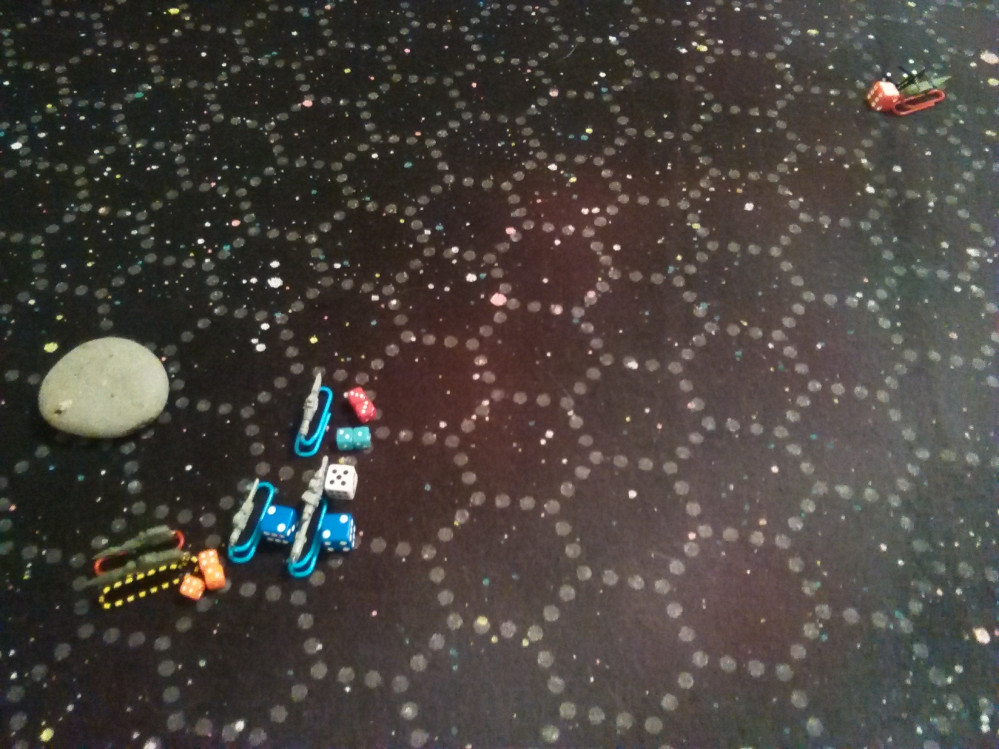
tidewater Darkstar
Recommendations: 74
About the Project
After expressing interest upon the discovery of the famous Let's Play episode, getting posts from the creator for new ships, acquiring a felt hex-mat, and realizing that our Battlefleet Gothic's smallest ships... were too big, it sadly stayed unplayed. Then at the end of 2020, I finally took another serious look at laying down ships and cutting counters for craft. At first, we paid no money. Everything we used in game #1, from tiny 4-5mm dice for torpedoes, fighters, bombers, & others, to the stands made from small paperclips, to the plastic parts used for conversion ship models was already in hand. Well, we needed sleeves for dry-erase marking of damage on WRS's. And later alphabet & number beads for better counters. And Lego to build a crude starmap model (to correct misperception of distances). But we were blundering our way into Darkstar, and learning from our mistakes. Mainly misreading or missing rules, sometimes missing out on sound judgement. I can't promise frequent posts, but hopefully the activity level will not appear dead to any who find these words and images...
Related Genre: Science Fiction
This Project is Active
Convoy My Condolences
[Campaign Day 12, Gl.432, outer asteroid belt]
Previously, the Canadian Battlegroup Sable was stopped cold at Gliese 432, with Oakville being forced back under tow to 442 to begin repairs at a new secret facility expected to become operational by the time of her arrival. Frontenac was retained, while Sault Ste. Marie was sent back. Huron arrived with Niagara, bringing the total Canadian deployment in the outskirts of Gliese 432 up to 3, with Battlegroup Wolverine’s hybrid carrier and destroyer assisted by Sable’s frigate. While the Japanese would not commit the heavily damaged Narikei, other ships were assigned to a military convoy to deliver the first components for a repair base.
I hastily improvised a scenario by going off of the entry in the rulebook, and upped the “hit points” for just 2 transports, starting just on the board, moving across the diagonal, and adjusted their speed so that we would have about 4 turns to stop them (at the start of the 5th they would move off). As I remember, destroying all transports would earn an extra point on top, while saving all would earn that side a bonus, as well as killing escorts and attackers…
From an image taken just before the battle, it seems that the Japanese 2nd Advance Group may have been used in its entirety, probably because the crippled frigate was either deemed so lightly damaged it could be repaired, or we thought a replacement was alright given that it might have been lost in the interim (he lost quite a few, and it was hard to keep track when names were not always written in).
Again, records are incomplete, and while 1 transport was struck down, it looked like by the last turn, not much fire could be brought to bear on the remaining one, and losses on both sides pointed to a draw. We know of atleast 1 Japanese ship, probably a strike frigate, being lost, and possibly a second. For the narrative, the base would be established but with some delays. The expeditionary cruiser Huron and the frigate Frontenac would be all that was left to keep up the pressure on the Japanese.
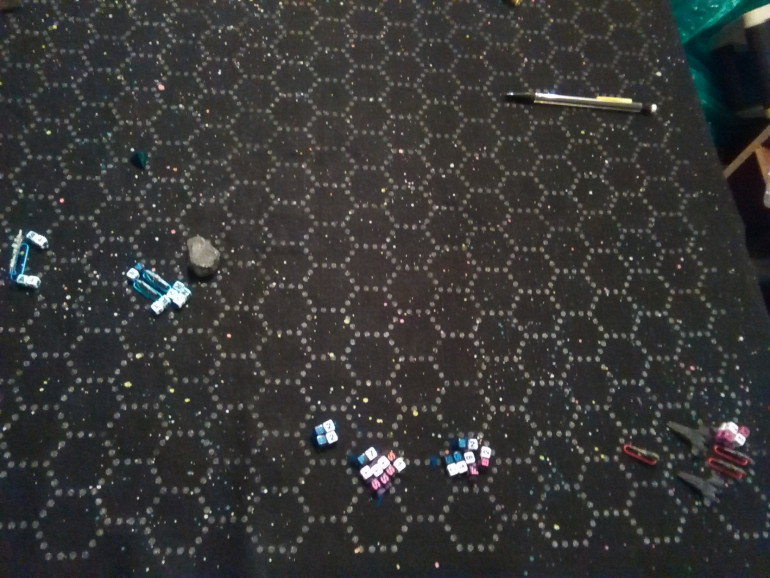 The Canadian force tries to lean in close enough to deliver all fire at maximum range, but some are just out. The wedge-shaped transports begin their transit from bottom right while aerospace units meet between the fleets...
The Canadian force tries to lean in close enough to deliver all fire at maximum range, but some are just out. The wedge-shaped transports begin their transit from bottom right while aerospace units meet between the fleets... NIAGARA is tailed by the Japanese NARIKYO and HISHA with all torpedoes converging on the 2 parties, with scouts and fighters trying to interpose
NIAGARA is tailed by the Japanese NARIKYO and HISHA with all torpedoes converging on the 2 parties, with scouts and fighters trying to interpose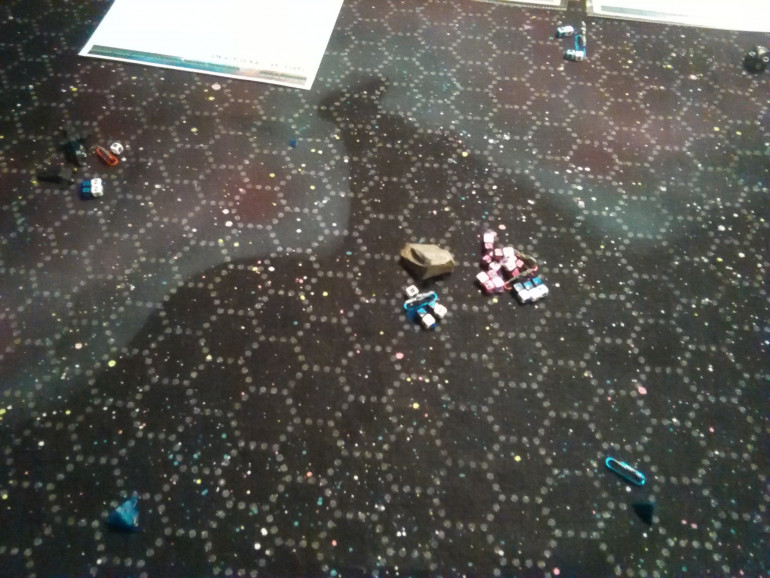 With 1 transport crippled and the other lightly damaged with a crippled escort on the same heading, the Japanese make their escape as such. Seen in the center below the asteroid, NIAGARA had been hit so forcefully she nearly exploded, while FRONTENAC at bottom right and HURON at the top right had trouble making high speed turns back into the fight.
With 1 transport crippled and the other lightly damaged with a crippled escort on the same heading, the Japanese make their escape as such. Seen in the center below the asteroid, NIAGARA had been hit so forcefully she nearly exploded, while FRONTENAC at bottom right and HURON at the top right had trouble making high speed turns back into the fight.Forgotten Follow-up Foul-up
[Campaign Day 08, Gl.432, asteroid belt]
This next episode was first delayed by a mandate from the Institute of Procrastination, but once that passed over I realized I had a great deal of trouble remembering what actually happened. The few images don’t give an intelligence outfit much to go on, especially without the set of WRS’s from immediately after that particular fight. I knew we chalked it up to a Canadian loss, but aside from the scale being tipped that way, we can only see 1 Japanese ship (with red base) with a hashtag # cube marking it “crippled”, and 2 Canadian ships (blue bases) that have little cubes with a heart ♥ next to them, which we began using to indicate ships “breaking off”, or forced to flee because of loss of life, or the excessive risk of such.
It was very likely here in this battle that Frontenac, a Cornwallis Class frigate, suffered a comical series of hits that drilled from her starboard quarter clean through to the port side, with enough torpedoes for the last one to explode Completely Outside the Ship on the Other Side. -That earned the ship and crew an extra point of experience.
I also seemed to recall in one of these early battles, we hadn’t got the ‘rules for fleeing’ down right, and I let a small corvette (Oakville) linger a bit too much. (She should have turned towards that corner, and never looked back) While drawing fire off of a friendly ship by shooting with little effect, she herself took enough damage to become crippled rather than just leaving early, which tipped the outcome in whichever game that was. Probably this one…
What we do know:
The Canadian’s Battlegroup Sable, consisting of a destroyer, frigate, and corvette, moved ahead to Gliese 432, with the 2nd Advance Group of the Japanese (with a destroyer and 2 frigates) meeting them amongst a cluster of asteroids. Results were such that the Canadian force was in retreat, while the Japanese would begin plans to establish a forward base near there, very close to the end goal for both sides, the habitable star system at Gliese 433…
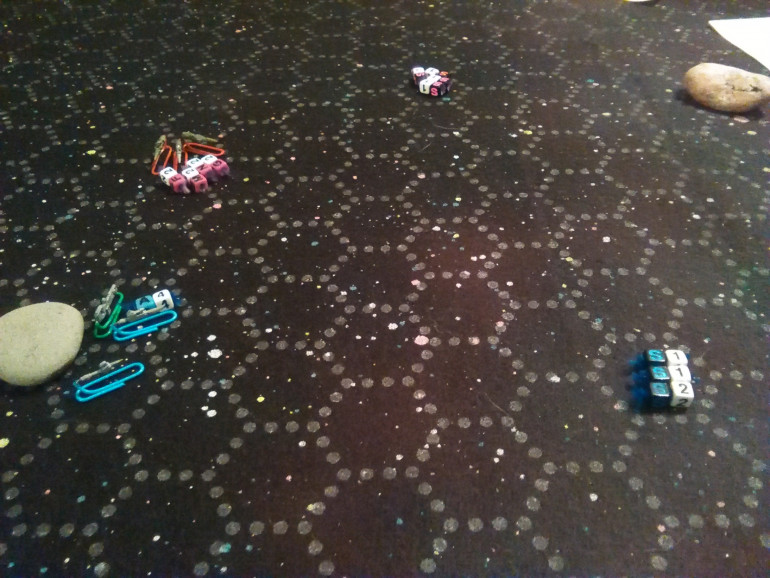 Sault Sainte Marie (Clarino Class destroyer), Frontenac (Commonwealth Class frigate), & Oakville (derived Ashur Class corvette) faced off against the Japanese 2nd Advance Group.
Sault Sainte Marie (Clarino Class destroyer), Frontenac (Commonwealth Class frigate), & Oakville (derived Ashur Class corvette) faced off against the Japanese 2nd Advance Group.Early Encounter
Finally, some talk of fighting! I was going to complete an elaborate narration of the background to our campaign, but after drafting a few historical details, speculating only part of the story into life, and sounding more like the book I was reading on Pacific Theater strategy in 1942, I had to go back to the battle. I mean we honestly just wanted to play some games and get experience. So maybe a little later… For now, our first battle of the campaign, a meeting engagement in the asteroid belt of Gliese 442, Canadians vs. Japanese:
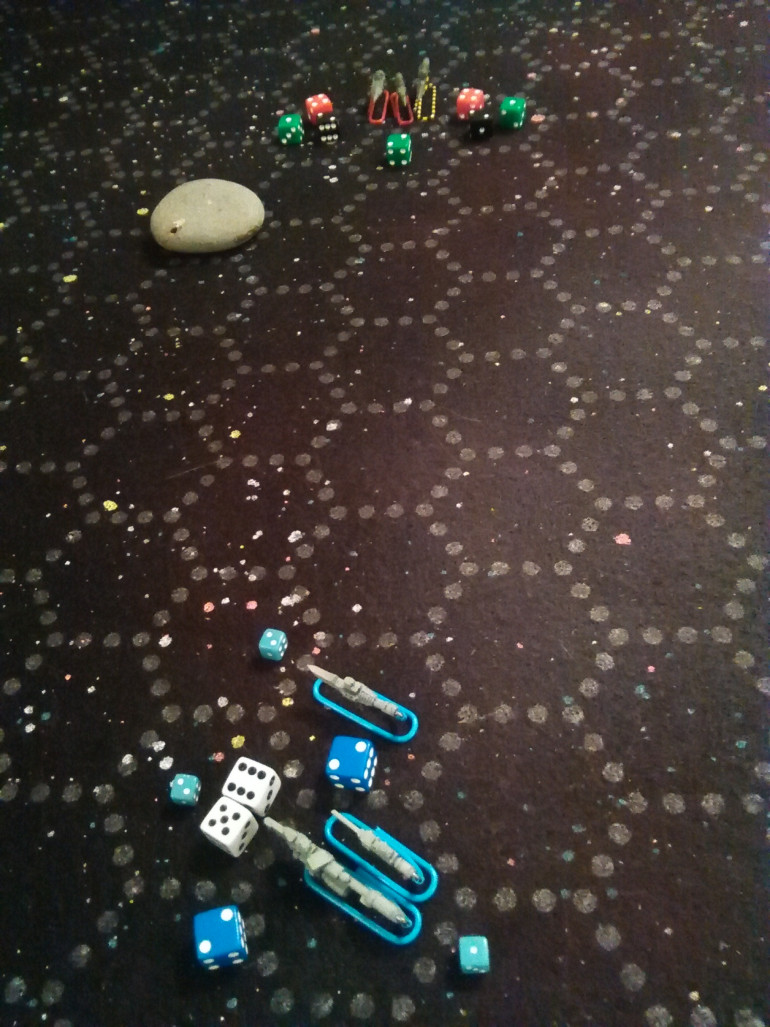 The ball opens: the IJN' 1st Advance Group of KISHIJOTEN, SOYOKAZE, & NARIKEI approaches at high speed as Battlegroup Wolverine with HURON & MACKINAW bearing up right behind NIAGARA
The ball opens: the IJN' 1st Advance Group of KISHIJOTEN, SOYOKAZE, & NARIKEI approaches at high speed as Battlegroup Wolverine with HURON & MACKINAW bearing up right behind NIAGARAThe tiny D6’s we used here are the first things we used to represent aerospace (scouts, fighters, etc.) and torpedoes (& missiles), so you see everyone launched everything they could. I used blue bases for my Canadians, while the Japanese group leader Narikei (a Taiho-Class Light Cruiser) had a yellow & black striped base, leading the others with red.
My commander’s Maecenas-Class Expeditionary (Light) Cruiser Huron performed well with firepower and fighters, while my Commonwealth-Class destroyer Niagara almost got ahead of herself.
Early on, my Canadians targeted the Japanese Shimada-Class light carrier Kishijoten, and while she wasn’t crippled (we missed all vitals?!), luckily for me he failed his break-off test. But we probably didn’t do the escape move right; he wanted to push straight through my general location, and I said ‘how ’bout the other corner to the left’ (which might have not been the closest).
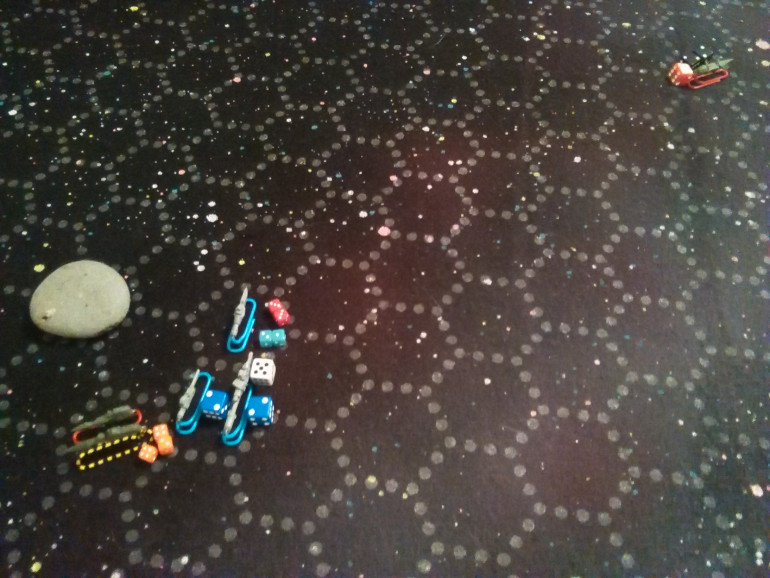 HURON & MACKINAW manage broadsides on the sterns of NARIKEI & SOYOKAZE, with NIAGARA again slightly ahead, whilst KISHIJOTEN is making for home...
HURON & MACKINAW manage broadsides on the sterns of NARIKEI & SOYOKAZE, with NIAGARA again slightly ahead, whilst KISHIJOTEN is making for home...Near as I can tell from photo no#2, it’s likely turn 2, and in picture 3 we can see the damage that somehow scared the crew or AI of Kishijoten into leaving the party early. The next image confirms the result of Japanese return fire after a stern-raking. The Shephard-Class Frigate Mackinaw is Crippled through the Port Quarter, with a roll of 6 on a 5+.
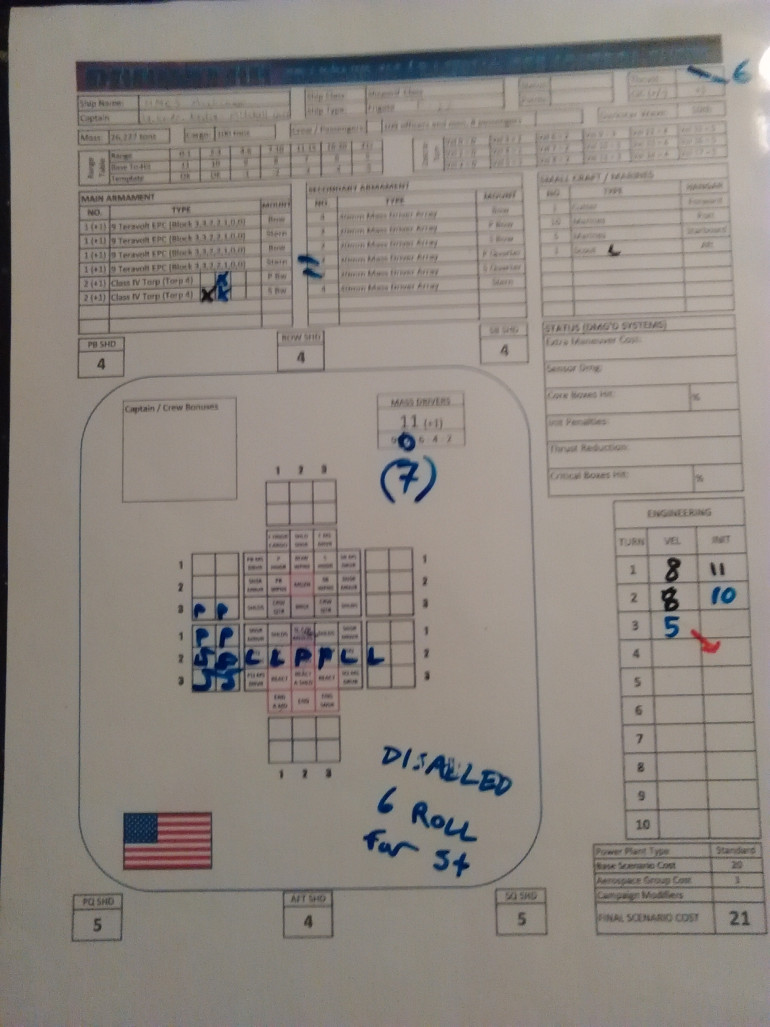 Yes, I put an American ship into British (ahem, Canadian?) service; sorry, but it doesn't stop there. Anyways, you can see the letters I used to know specifically how it hurt, or atleast the weapons used, with Lasers & Plasma punching through my powerplant connection...)
Yes, I put an American ship into British (ahem, Canadian?) service; sorry, but it doesn't stop there. Anyways, you can see the letters I used to know specifically how it hurt, or atleast the weapons used, with Lasers & Plasma punching through my powerplant connection...)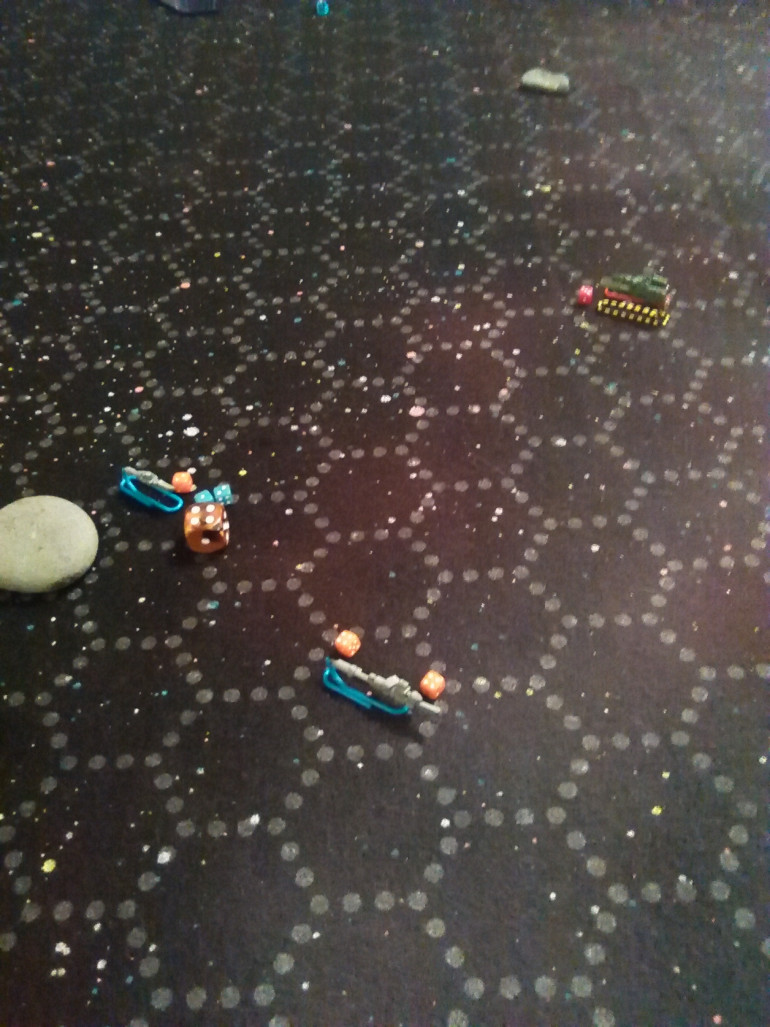 Near the end, when HURON veers away from an asteroid, NIAGARA hugging it closely, receiving fire. But although the Japanese are worse for wear, they are not Crippled nor breaking off, and their formation is tight.
Near the end, when HURON veers away from an asteroid, NIAGARA hugging it closely, receiving fire. But although the Japanese are worse for wear, they are not Crippled nor breaking off, and their formation is tight.It was difficult to recall all the details weeks later, but fortunately I got shots of all six WRS showing the results before we cleared all the marker off. And for anyone who can see it on the WRS’s, any of the Initiative numbers that seem impossible for absolute beginners with no upgrades, that’s because we added CIC bonuses to… everything. The logic flowed from noticing a penalty would result if the bridge took any hits. As the rules and the writer will confirm, only Thrust value and Specific Upgrades add to the intiative roll… (Back to the account:)
The Light Cruiser and Kagumo-Class Destroyer Soyokaze took more damage in the end than their counterparts, but were not driven from the space, so we determined the fight was a draw. Although with the Japanese forces being further from their main base, they would not seek battle this far out again -for now…
The Setting of the Order of Battle
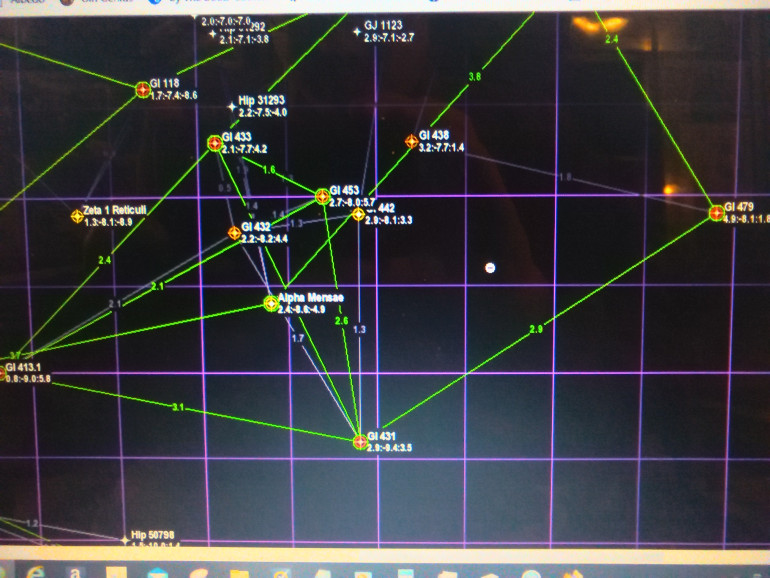 the chosen one(s): a crude screen capture from www.projectrho.com showing the galactic neighborhood we moved into
the chosen one(s): a crude screen capture from www.projectrho.com showing the galactic neighborhood we moved intoOur campaign is really a thing, honest! And as shown above, our battles have a place or two. You could ignore Alpha Mensae, and a few outliers; if you check out the coordinates listed in Parsecs, you would eventually realize how far above or below some of these are from others. So close, yet so far.
With the help of some correspondence from Oriskany, I can tell you some of the stars feature amongst the constellations Hydra and Cetus.
The 8 star systems we plan to use have no names… yet. Their rays are numbered: Gliese 413.1, 431, 432, 433, 438, 442, 453, & 479. I actually built a 3D model out of Lego (& then updated it) to better visualize their relation to each other. In fact, I realized the best way to build it with limited resources was not to plot X and Y on the plate, but instead X and Z, with the stacked up towers being Y. One iteration of the model can seen below:
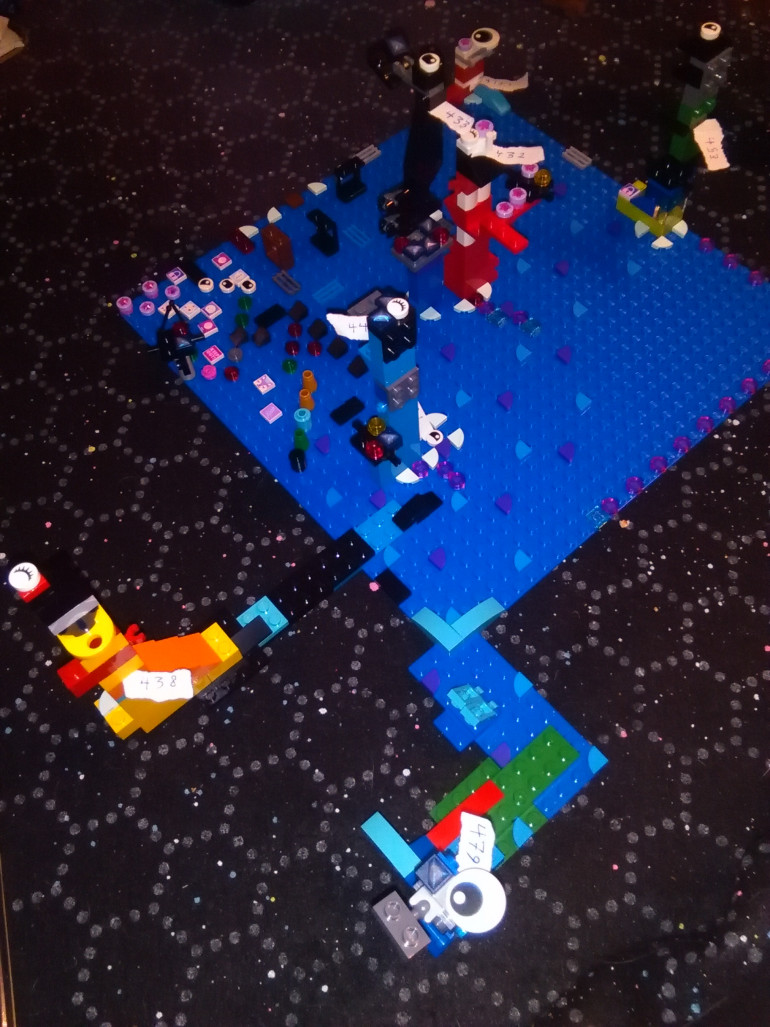 There's alot of extra parts stuck to the board, but most of the star systems have a torn paper tag with the Gliese number and those points are white discs with eyes painted on (some are closed eyes). Also a grid of blue quarter-circles shows relative coordinates, while purple ones mark the actual coordinates, each at intervals of five. I added up to four of these quarters in very light blue around the base of each star location to highlight them further. Canadian Base is closest to bottom of image, Japanese Base is the furthest up the top/middle
There's alot of extra parts stuck to the board, but most of the star systems have a torn paper tag with the Gliese number and those points are white discs with eyes painted on (some are closed eyes). Also a grid of blue quarter-circles shows relative coordinates, while purple ones mark the actual coordinates, each at intervals of five. I added up to four of these quarters in very light blue around the base of each star location to highlight them further. Canadian Base is closest to bottom of image, Japanese Base is the furthest up the top/middleWe have our stage, although we’re really only using a few places in the middle, with the Canadian main base at [Gliese] 479, and a Japanese anchorage at [Gliese] 413.1. But now comes a part where we really strayed from the beginner’s program. It is suggested to new players (which we still are) that each take a Battlegroup of a destroyer and 2 frigates, or atleast 2 such Battlegroups, and proceed thus. Carriers not recommended, but definitely assuming only one nation’s ships will be used for each player’s fleet.
But I wanted to try out Light Cruisers, so I said “let’s allow it” and picked the British, except I thought Canadian. And my light cruiser was a weird hybrid carrier. (I actually thought of a bizarre faction that would somehow tie together Scandinavian with North American Natives and all the Europeans inbetween, but dropped the unwieldly idea)
Then I looked up bit of 20th century Canadian Naval history, and thought American ships can also work! And then I thought, the story of the Oakville was too good to ignore, but none of the available British or American ships fit the concept, so an Arab League corvette was selected, almost at random!
In future, I hope to keep each player’s fleet to one “national source” -especially myself. At any rate, here is where we started, the Canadian Expeditionary Force vs. the Japanese Advance Force:
 1st Column (L) ["Sable"]: Destroyer HMCS Sault Sainte Marie, Frigate HMCS Frontenac, corvette HMCS Oakville; 2nd column ["Wolverine"]: Expeditionary (Light) Cruiser, HMCS Huron, Destroyer HMCS Niagara, Frigate HMCS Mackinaw; 3rd column [1st Advance Force]: Light Cruiser IJN Narikei, Light Carrier (destroyer) IJN Kishijoten, Destroyer IJN Soyokaze; 4th column (R) [2nd Advance Force]: Destroyer IJN Narikyo, Strike Frigate IJN Hisha, Strike Frigate IJN Yuki
1st Column (L) ["Sable"]: Destroyer HMCS Sault Sainte Marie, Frigate HMCS Frontenac, corvette HMCS Oakville; 2nd column ["Wolverine"]: Expeditionary (Light) Cruiser, HMCS Huron, Destroyer HMCS Niagara, Frigate HMCS Mackinaw; 3rd column [1st Advance Force]: Light Cruiser IJN Narikei, Light Carrier (destroyer) IJN Kishijoten, Destroyer IJN Soyokaze; 4th column (R) [2nd Advance Force]: Destroyer IJN Narikyo, Strike Frigate IJN Hisha, Strike Frigate IJN YukiSize by Silhouette, Logic of Length
Looking back from today’s entry, the images of ships are still lacking. So let’s go back in space and time to the point in their development where I went from “don’t know what this one will be, but it looks good” to “I need to able to tell these apart by type/size.” Below you can better see side profiles, as well as dead giveaways of what parts made them:
I should probably mention that these models and the others I have since made are not what I would consider ideal; in other words, given the time, tools, talent, and tchoice, I would not make those fine ship class designs wear these crude mockups. But they are functional, and fulfilled my desire to represent inverted (rolled over) ships, and also allowed me to use a cheap and very simple base (a “trombone” paperclip). I would love to create a fine-detailed model or 2 or 22 or 200 that each could sit inside a tiny box of clear resin to protect it and allow it to roll over by being flipped opposite, and maybe on its side to represent being crippled, but again the ones here are alright (although my chosen parts are limiting).
Capsized captured (smaller than a cap, and not crippled)
In the 1st entry, that last image was basically… Not An Image. So here is a better look at what I meant by INVERSION (tm?):
 Smallest ships at the bottom, from Corvette, Frigate, Destroyer, and Light Cruiser, all shown rolled over to flip port & starboard sides. Hopefully now you can see green and red lights painted on, with wire bases attachment through the stern. The bottom one was supposed to be a Frigate, but maybe it's closer to Corvette size?
Smallest ships at the bottom, from Corvette, Frigate, Destroyer, and Light Cruiser, all shown rolled over to flip port & starboard sides. Hopefully now you can see green and red lights painted on, with wire bases attachment through the stern. The bottom one was supposed to be a Frigate, but maybe it's closer to Corvette size? Les Pieces Des Resistance
To begin, I figured showing this first would be the most valuable to any who see this. Which is one way of making counters and ships for this game:
Card or cardboard or cardstock counters cut from old… sprues? frames? that came from various boardgames (& some boxed wargames) we’re what I was hoping to use, but then I tried the first flimsy wedges on my natty felt hex-mat, and that was a deadend. (Fine for any other smooth or solid surface maybe)
So, after hemming and hawing about buying beads (?!), I bought up a handful of randomly assorted letter and number cubes with cylinder shaped channels for cording. I’m hoping to find a foam-wrapped wire later, but some small “pipe-cleaners” cut to tiny lengths are serviceable for now
Ships were made from plastic parts, some inverted from normal orientation to hide their origins better. Also, because the rules featured INVERSION(tm), & I had remembered some Star Wars X-Wing models (e.g. the B-Wing) being attached from the rear/engine area, I knew I wanted basing to connect to the stern. Everything I looked at making was too complicated. For example, if I made a base that could comfortably & securely hold 3 ships, you would have to pluck a ship out Everytime you moved -1 ship at a time because of initiative- or atleast everytime they separated. So I was about to give up when I looked at my tiny drill bits and some tiny paperclips that had a coat of sorts (like sheathing for a wire). To make each base, the “trombone” inner loop was carefully extended up at an angle to one end, stripped off about a 1/4-inch, then bent from there to point level & “forward” to make the mounting pin. Tiny red/green ship lights were painted on the underside in an order that would clue an observer that not only was the “belly up”, but that starboard (green) & port (red) were reversed.
 The 'code' of the markings/colors is letter first for type, then number. Numbers are always black over white; craft are neon color letter over black (fewer colors, but more of each letter). All ordnance (torpedoes, missiles) are black letters over various colored backgrounds, more colors to tell launching ships apart.
The 'code' of the markings/colors is letter first for type, then number. Numbers are always black over white; craft are neon color letter over black (fewer colors, but more of each letter). All ordnance (torpedoes, missiles) are black letters over various colored backgrounds, more colors to tell launching ships apart. 




























